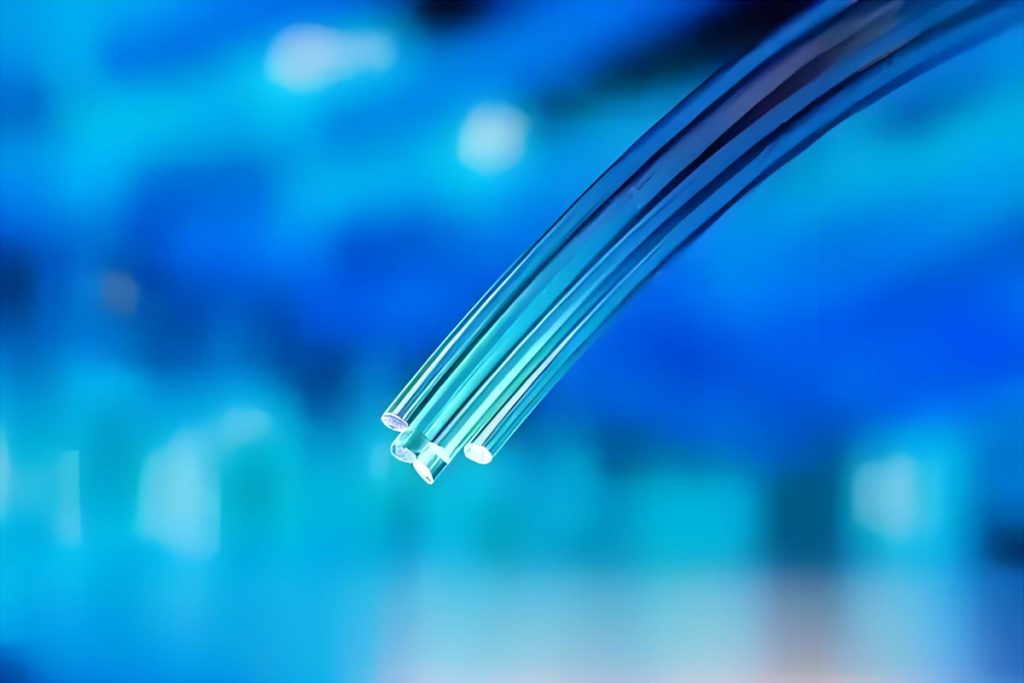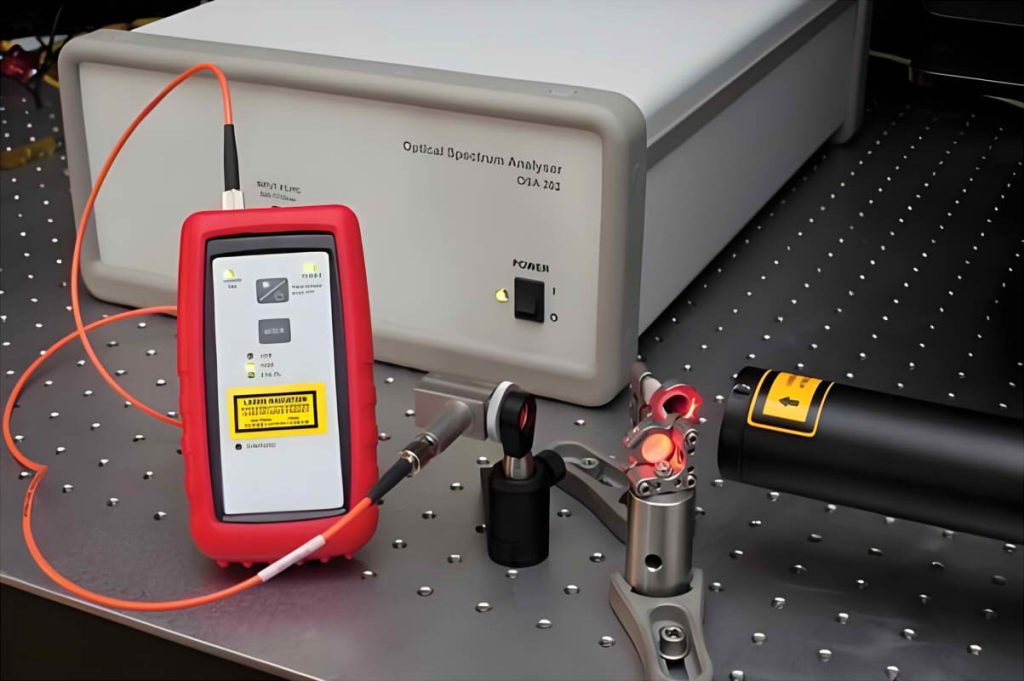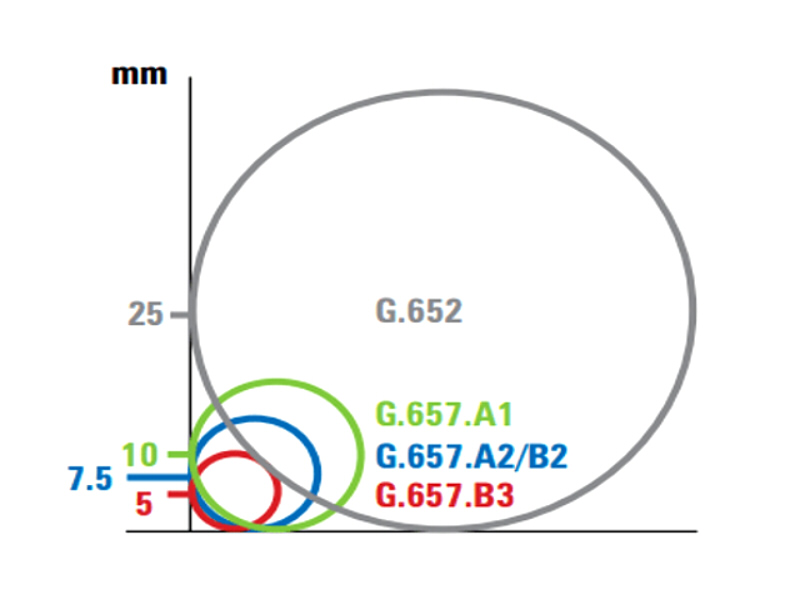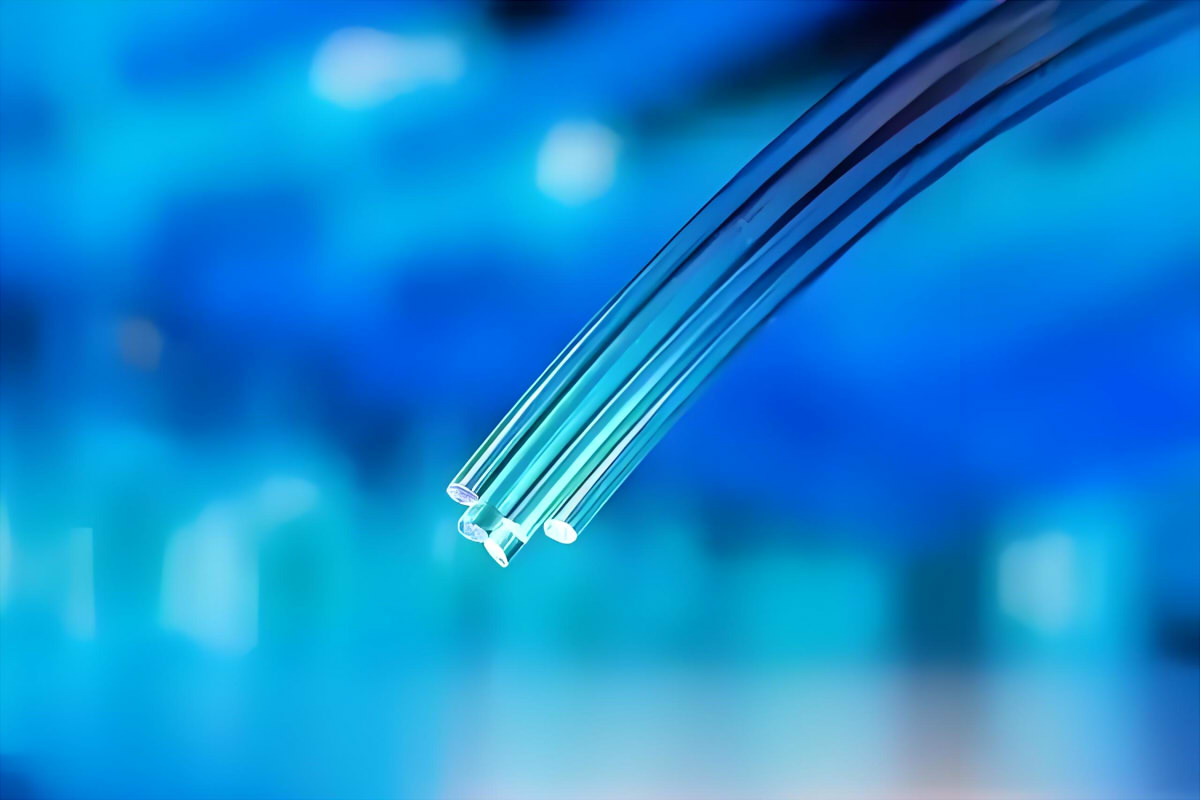G652D fiber optic (non-dispersive displacement single-mode fiber) It is suitable for transmission systems across the entire spectrum. 1260 a 1625 nm. Optimizes attenuation and dispersion characteristics across this spectrum, while improving performance against macrobends in the L-band (1565 a 1625 nm).
The mode field diameter of G652D optical fiber (width of the fiber where the signal propagates) It is 10,1 μm. Its maximum radius of curvature is 25 mm. This type of fiber can meet the need for high-speed multi-channel transmission on a single fiber..

It is suitable for various types of optical cable structures, including ribbon cables, stranded slack cables, skeleton cables, central loose tube cables, tight sheath cables, overhead cables ADSS of the OPGW, among others.
Table of Contents
- Parameters of G652D Fiber
- History of the development of ITU-T G652D
- G652D Fiber Optic Applications
- What is the Difference between G652D Fiber and G657 Fiber?
- Conclusion
Parameters of G652D Fiber
Optical Properties
| Features | Conditions | Data | Unit |
|---|---|---|---|
| Attenuation | 1310nm | ≤0.34 | dB/km |
| 1383nm (after hydrogen aging) | ≤0.34 | dB/km | |
| 1550nm | ≤0.20 | dB/km | |
| 1625nm | ≤0.24 | dB/km | |
| Variation of attenuation with respect to wavelength | 1285-1330nm (with respect to 1310nm) | ≤0.03 | dB/km |
| 1525-1575nm (respecto a 1550nm) | ≤0.02 | dB/km | |
| Dispersion in the wavelength range | 1285-1340nm | -3.5~3.5 | ps/(nm•km) |
| 1550nm | ≤18 | ps/(nm•km) | |
| 1625nm | ≤22 | ps/(nm•km) | |
| Null Dispersion Wavelength (λo) | – | 1300~1324 | nm |
| Zero dispersion slope (So) | – | ≤0.092 | ps/(nm^2•km) |
| Typical value of null dispersion slope | – | 0.086 | ps/(nm^2•km) |
| Fiber Optic Cutting Wavelength (λcc) | – | ≤1260 | nm |
| Mode diameter (MFD) | 1310nm | 8.7~9.5 | µm |
| 1550nm | 9.8~10.8 | µm | |
| Effective refractive index (Neff) | 1310nm | 1.466 | – |
| 1550nm | 1.467 | – | |
| Punctual discontinuity | 1310nm | ≤0.05 | dB |
| 1550nm | ≤0.05 | dB |
Geometric Properties
| Features | Conditions | Data | Unit |
|---|---|---|---|
| Liner diameter | – | 125.0±0.7 | µm |
| Non-roundness of the coating | – | ≤1 | % |
| Coating diameter | – | 235~250 | µm |
| Coating/lining concentricity error | – | <12 | µm |
| Non-roundness of the coating | – | ≤6 | % |
| Core/cladding concentricity error | – | ≤0.6 | µm |
| Radius of curvature | – | ≥4 | m |
| Delivery length | – | Max. 50.4 | km/rollo |
Environmental Performance (1310nm, 1550nm y 1625nm)
| Features | Conditions | Data | Unit |
|---|---|---|---|
| Additional temperature dimming | -60°C ~85°C | ≤0.05 | dB/km |
| Additional dimming by temperature-humidity cycle | -10°C ~85°C 98% relative humidity | ≤0.05 | dB/km |
| Additional dimming by immersion in water | 23℃, 30 days | ≤0.05 | dB/km |
| Additional moisture attenuation | 85℃, 30 days 85% relative humidity | ≤0.05 | dB/km |
| Dry heat aging | 85℃, 30 days | ≤0.05 | dB/km |
Mechanical Performance
| Features | Conditions | Data | Unit |
|---|---|---|---|
| Screening voltage | – | ≥9.0 | N |
| – | ≥1.0 | % | |
| – | ≥100 | kpsi | |
| Additional Macrocurvature Loss | |||
| 100 turns, radio 30mm | 1625nm | ≤0.05 | dB |
| 100 turns, radio 25mm | 1310nm y 1550nm | ≤0.05 | dB |
| 1 vuelta, radio 16mm | 1550nm | ≤0.05 | dB |
| Coating Peel Force | Typical average value | 1.5 | N |
| Maximum value | 1.3~8.9 | N | |
| Dynamic fatigue parameter (nd) | – | >20 | – |
History of the development of ITU-T G652D
At the end of the decade 1970, An attempt was made to replace emitting diode light sources with long-life semiconductor lasers to achieve greater communication distances and greater capacity.. Nevertheless, when transmitting lasers in multimode fiber, modal noise was generated.
To overcome modal noise, in 1980 single-mode fiber with zero point dispersion was successfully developed at a wavelength of 1310 nm (also known as standard single mode fiber). The THAT'S T (International Telecommunication Union, Telecommunications Standardization Sector) recommended defining this fiber as G652 fiber. Since single-mode fiber only transmits one mode, the modal noise that occurs in multimode fiber is not produced.

In the middle of the decade of 1980, fiber optic communication system 140 Mbit/s, Composed of standard single-mode fiber and laser sources, became the main communication method adopted by the telecommunications industry. The retransmission distance and transmission capacity far exceeded that of the coaxial cable transmission system, which allowed fiber optic communication systems to gradually replace cable communication systems. copper conductor cables.
Recommendation G.652 was created by the group 15 of the ITU-T during the study period of 1981-1984, with its first version (V1.0) published in October 1984. Posteriorly, Four modifications were made to 1988, 1993, 1997 Y 2000, giving rise to version V5.0. In this version, G.652 fiber was subdivided into two types: G.652A and G.652B.
At the group meeting 15 of the ITU-T held in Geneva in 2003, two additional types were introduced, G.652C y G.652D, in version V6.0 (March 2003), and the upper limit of the L band was established at 1625 nm. Posteriorly, modifications were made to 2005, 2009 Y 2016. in august this year 2024, some parameters were reviewed, and in this review, indicative examples were provided on the statistical dispersion coefficient in patch cables with M equal to 1 until 16.
The G652A and G652B are the most suitable for operating in the 1310 nm. Nevertheless, neither is suitable for wavelength division multiplexing applications (WDM). The most advanced G652C and G652D eliminate water peak for full spectrum operation, allowing them to be used in the wavelength region between 1310 nm y 1625 nm to support coarse wavelength division multiplexing transmission (CWDM).
G652D Fiber Optic Applications
- Used in short and long distance network applications, like LAN, MAN and access networks.
- G652D fiber eliminates water spikes across the entire spectrum, allowing the simultaneous use of 1310 nm y 1550 nm for coarse wavelength division multiplexing transmissions (CWDM).
- G652D is compatible with OS1 and OS2 structures, so it can be used in optical cable networks both indoors and outdoors.
- It is used in the field of microoptics, as in the manufacture and application of small optical components.
What is the Difference between G652D Fiber and G657 Fiber?
G652D and G657 are two common types of single-mode fiber that have notable differences, mainly in core design, performance and application scenarios.
The G652D fiber core is a conventional single-mode core, designed to offer low transmission losses and high bandwidth in long distance transmissions. It is characterized by its low transmission losses and maximum bandwidth, making it suitable for applications that require high performance in long distance transmissions, like metropolitan networks (MAN), remote transmission and fiber to the home (FTTH). In a specific range of wavelengths, offers the lowest transmission loss, and is usually used in standard long distance transmissions.
G657 fiber is an evolution developed from G652 to meet fiber-to-the-home goals (FTTH). Its main characteristic is its excellent resistance to bending., with a radius of curvature that can be between 1/4 Y 1/2 of the curvature radius of conventional G652 fiber.

In summary, for long transmission distances exceeding 100 km (like LAN and MAN) and with cable curvature radii greater than 25 mm, the G652D provides the best performance. Nevertheless, in short distance and densely installed applications (like FTTH), G657 single-mode fiber is the ideal option, In addition to being more economical.
Conclusion
In conclusion, the single-mode optical fiber G652D has established itself as a key option in short and long distance optical communications thanks to its design optimized to transmit across the entire spectrum and its low transmission losses.. Usually, The most appropriate fiber must be selected based on the specific needs of each installation.

